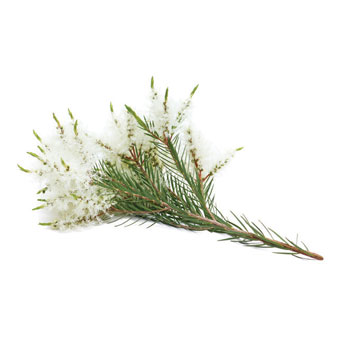Correia AM, Pedrazzani AS, Mendonça RC, Massucatto A, Ozório RA, Tsuzuki MY Brazilian Journal of Biology, 2017 ABSTRACT: In this study were evaluated the anaesthesia and analgesic effects of clove Eugenia caryophyllata, tea tree Melaleuca alternifolia and basil Ocimum basilicum essential oils (EO) during handling of yellowtail clownfish Amphiprion clarkii. Juveniles (3.70 ± 0.75 cm and 1.03… Read more »

- Botanical Name: Melaleuca alternifolia
- Alternative Names: Tea tree
- Botanical Family: Myrtaceae
- Primary Constituent: Terpinen-4-ol
- Other Main Constituents: Gamma terpinene
- Distillation Method: Steam Distillation
- Plant Part: Leaf
Lactoferrin, chitosan and Melaleuca alternifolia-natural products that show promise in candidiasis treatment
Felipe LO, Júnior WFDS, Araújo KC, Fabrino DL Brazilian Journal of Microbiology, 2017 ABSTRACT: The evolution of microorganisms resistant to many medicines has become a major challenge for the scientific community around the world. Motivated by the gravity of such a situation, the World Health Organization released a report in 2014 with the aim of… Read more »
Melaleuca alternifolia Induces Heme Oxygenase-1 Expression in Murine RAW264.7 Cells through Activation of the Nrf2-ARE Pathway
Lee SY, Chen PY, Lin JC, Kirkby NS, Ou CH, Chang TC American Journal of Chinese Medicine, 2017 ABSTRACT: Melaleuca alternifolia concentrate (MAC) is the refined essential oil of the Australian native plant Melaleuca alternifolia. MAC has been reported to suppress the production of pro-inflammatory cytokines in both murine RAW264.7 macrophages and human monocytes stimulated with lipopolysaccharide… Read more »
Chemical composition and anti-Acanthamoeba activity of Melaleuca styphelioides essential oil
Albouchi F, Sifaoui I, Reyes-Batlle M, López-Arencibia A, Piñero JE, Lorenzo-Morales J, Abderrabba M Experimental Parasitology ABSTRACT: Acanthamoeba infections cause serious humans diseases, such as amoebic keratitis and granulomatous amoebic encephalitis. Melaleuca essential oil has been reported to be effective in treating bacterial and fungal infections. However, the anti-parasitic effects of this essential oil are not well studied. In… Read more »
Antifungal activity of essential oils on two Venturia inaequalis strains with different sensitivities to tebuconazole
Muchembled J, Deweer C, Sahmer K, Halama P Environmental Science and Pollution Research, 2017 ABSTRACT: The antifungal activity of seven essential oils (eucalyptus, clove, mint, oregano, savory, tea tree, and thyme) was studied on Venturia inaequalis, the fungus responsible for apple scab. The composition of the essential oils was checked by gas chromatography-mass spectrometry. Each essential oil had its main compound…. Read more »
Antifungal properties of essential oils for improvement of indoor air quality: a review
Whiley H, Gaskin S, Schroder T, Ross K Reviews on Environmental Health, 2017 ABSTRACT: Concerns regarding indoor air quality, particularly the presence of fungi and moulds, are increasing. The potential for essential oils to reduce, control or remove fungi, is gaining interest as they are seen as a “natural” alternative to synthetic chemical fungicides. This review examines published… Read more »
iTRAQ Proteomic Analysis Reveals That Metabolic Pathways Involving Energy Metabolism Are Affected by Tea Tree Oil in Botrytis cinerea
Xu J, Shao X, Wei Y, Xu F, Wang H Frontiers in Microbiology, 2017 ABSTRACT: Tea tree oil (TTO) is a volatile essential oil obtained from the leaves of the Australian tree Melaleuca alternifolia by vapor distillation. Previously, we demonstrated that TTO has a strong inhibitory effect on Botrytis cinerea. This study investigates the underlying antifungal mechanisms at the molecular… Read more »
Anti-oxidant activity and major chemical component analyses of twenty-six commercially available essential oils
Wang HF, Yih KH, Yang CH, Huang KF Journal of Food and Drug Analysis, 2017 ABSTRACT: This study analyzed 26 commercially available essential oils and their major chemical components to determine their antioxidant activity levels by measuring their total phenolic content (TPC), reducing power (RP), β-carotene bleaching (BCB) activity, trolox equivalent antioxidant capacity (TEAC), and 1,1-diphenyl-2-picrylhydrazyl free… Read more »
Four terpene synthases contribute to the generation of chemotypes in tea tree (Melaleuca alternifolia)
Padovan A, Keszei A, Hassan Y, Krause ST, Köllner TG, Degenhardt J, Gershenzon J, Külheim C, Foley WJ BMC Plant Biology, 2017 BACKGROUND: Terpene rich leaves are a characteristic of Myrtaceae. There is significant qualitative variation in the terpene profile of plants within a single species, which is observable as “chemotypes”. Understanding the molecular basis… Read more »
Melaleuca quinquenervia essential oil inhibits α-melanocyte-stimulating hormone-induced melanin production and oxidative stress in B16 melanoma cells
Chao WW, Su CC, Peng HY, Chou ST Phytomedicine, 2017 BACKGROUND: Essential oils are odorous, volatile products of plant secondary metabolism, which are found in many leaves and stems. They show important biological activities, which account for the development of aromatherapy used in complementary and alternative medicine. The essential oil extracted from Melaleuca quinquenervia (Cav.) S.T. Blake (paperbark)… Read more »
